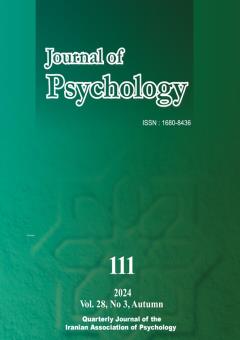An integrated model of social anxiety disorder based on influential factors: biological, familial, cognitive, behavioral, emotional and social in Female Students
Subject Areas : روانشناسی
Mahdi Hassanvand Amouzadeh
1
![]() ,
Esmaeil Hashemi
2
,
mahnaz Mehrabizadeh Honarmand
3
,
hossein souri
4
,
Esmaeil Hashemi
2
,
mahnaz Mehrabizadeh Honarmand
3
,
hossein souri
4
![]() ,
Fatemeh Hakimi
5
,
Fatemeh Hakimi
5
1 - Department of Psychology, Faculty of Psychology and Education, Payame Noor University, Tehran, Iran.
2 - Department of Education and Psychology, Shahid Chamran University, Ahwaz, Iran
3 - گروه روانشناسی، دانشکده علوم تربیتی و روانشناسی، دانشگاه شهید چمران اهواز، اهواز، ایران
4 - Department of Psychology, Faculty of Psychology and Education, Payame Noor University University, Tehran, Iran
5 - 5. Department of Psychology, Faculty of Psychology and Education, Payame Noor University University, Tehran, Iran
Keywords: social anxiety, social-evaluative situations, safety behaviors,
Abstract :
Social anxiety is characterized by the fear of being observed and judged by another person in a social situation. Purpose of this study was to determine the structural relationships of behavioral inhibition and early maladaptive schemas with social anxiety through the mediation of social-evaluative situations, safety behaviors, emotion regulation, social thoughts and beliefs, self-beliefs to social anxiety. The research method is a descriptive-correlational study. The statistical society included all female students in Ahvaz Jundishapur University of Medical Sciences. Participants were 483 female students selected by available sampling method. The tools include Social Phobia Inventory(SPIN), Young Schema Questionnaire-Short Form (YSQ-3), Older Adult Social-Evaluative Situations Questionnaire (OASES), Social Phobia Safety Behaviors Scale(SPSBS), Emotion Regulation Questionnaire(ERQ), Mini- Social Thoughts and Beliefs Scale(Mini-STABS), Self-Beliefs Related to Social Anxiety Scale(SBSA), Behavioral Inhibition Systems (BIS). The data was analyzed by Pearson correlation and structural equation modeling. Fit indicators showed that the hypothetical research model has a good fit with the data (CFI=0.96, NFI=0.96, and RMSEA=0.07). Structural relations analysis showed Except emotion regulation, other variables had effect Standard coefficients with social anxiety. Considering the role of factors in the research model, it can be used in the design of SAD treatment in female medical students
